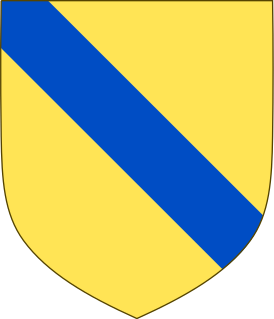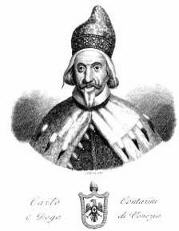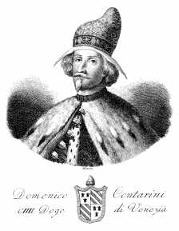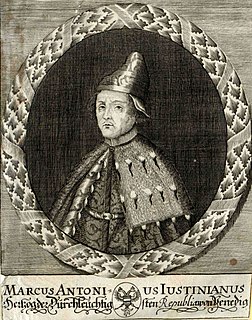
The Basilica dei Santi Giovanni e Paolo, known in Venetian as San Zanipolo, is a church in the Castello sestiere of Venice, Italy.

Francesco Morosini was the Doge of Venice from 1688 to 1694, at the height of the Great Turkish War. He was a member of a famous noble Venetian family which produced several Doges and generals. He "dressed always in red from top to toe and never went into action without his cat beside him."

The Morosini were a noble Venetian family that gave many doges, statesmen, generals, and admirals to the Republic of Venice, as well as cardinals to the Church. One legend says the family reached the Venetian lagoon in order to escape the invasion of Attila in northern Italy, and another source places the family’s origin namely in the city of Mantua. It first became prominent at the time of the emperor Otto II, 973–983, owing to its rivalry with the Caloprini family, which it subjugated by the end of the 10th century.

Reniero Zeno was the 45th Doge of Venice, reigning from 1 January 1253 until his death in 1268.

Domenico Morosini was the thirty-seventh doge of the Republic of Venice, reigning from 1148 until his death in 1156.

Marino Morosini was the 44th doge of Venice. He governed from 1249 to 1253.

Pietro Gradenigo was the 49th Doge of Venice, reigning from 1289 to his death.

Nicolò Tron was the 68th Doge of Venice, reigning from 1471 to 1473.

Antonio Venier was a Doge of Venice reigning from October 1382 to his death. He was interred in the Basilica di San Giovanni e Paolo, a traditional burial place of the doges. He was married to Agnese da Mosto.

Dogaressa was the official title of the spouse of the Doge of Venice. The title was unique for Venice: while the head of the Republic of Genoa were also called Doge, the wives of the Doges of Genoa were not called "Dogaressa", nor did they have such a public position.

Marino Grimani was the 89th Doge of Venice, reigning from 26 April 1595 until his death. Grimani's reign as doge was principally remembered for two reasons:
- the splendid celebrations for the coronation of his wife, Morosina Morosini; and
- the beginning of the quarrel with the papacy that resulted in Pope Paul V placing the Republic of Venice under papal interdict in the reign of Grimani's successor, Leonardo Donato (1606–1607).

Marcantonio Memmo was the 91st Doge of Venice, reigning from July 24, 1612 until his death.

Nicolò Contarini, was the 97th Doge of Venice, reigning from his election on 18 January 1630 until his death 15 months later. Contarini was the Doge who presided over Venice during the Italian plague of 1629–1631, which killed one third of Venice's population.

Carlo Contarini was the 100th Doge of Venice, reigning from his election on 27 March 1655 until his death a little over a year later.

Domenico II Contarini was the 104th Doge of Venice, reigning from his election on October 16, 1659 until his death.

Marcantonio Giustinian was the 107th Doge of Venice, reigning from his election on January 26, 1684 until his death. Giustiniani was the quintessential Doge of the Republic of Venice, taking little interest in affairs of state. He had little role in the conduct of the Morean War (1684-1699), which was raging during his time as Doge, though a number of military victories were secured by provveditore Francesco Morosini, who would later be Giustinian's successor as Doge.

Silvestro Valier or Valiero was the 109th Doge of Venice, reigning from his election on 25 February 1694 until his death six years later. The Morean War between the Republic of Venice and the Ottoman Empire, which had been ongoing since 1684, came to an end during Valier's reign as Doge, in January 1699.
This article presents a detailed timeline of the history of the Republic of Venice from its legendary foundation to its collapse under the efforts of Napoleon.

Federico Cornaro or Corner was a 14th-century Venetian patrician, merchant and politician. In 1379, he was accounted the richest man in Venice, having become wealthy from his sugar plantations in Cyprus. He used this wealth to buy his son a marriage with the heiress of the Lordship of Argos and Nauplia in Greece, which he de facto ruled in their name until his death.



















